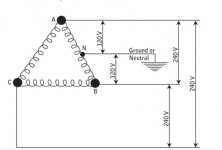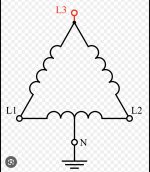If the 3-phase transformer is on a single core, at least some manufacturers also impose a limit on the unbalanced amount 120V load kVA on the two phases, for example the 5% of total kVA rating limit given by Schneider:
So that FAQ entry says a couple things I'm not clear on. One is that "Delta-Delta connected Transformers are intended to supply balanced three-phase loads, such as motors and compressors. Unbalanced loading can cause a circulating current to flow in the windings. This additional current is like a ``hidden`` load with the Transformer windings and can severely de-rate or even overload the Transformer."
Say I model each coil of the delta secondary as an idealized voltage source in series with an impedance Z, the same impedance for each coil. And suppose for the voltage sources, V1 + V2 + V3 = 0. Then for the coil currents I1, I2, and I3, the voltage difference between two corners of the delta will be V1 + I1*Z, etc, and must sum to zero around the delta. This implies I1 + I2 + I3 = 0. [As phasors, say.]
The upshot is that if you have single phase load currents J1, J2, and J3, if -(J1 + J2 + J3)/3 is non-zero, the coil currents will be offset from the load currents by -(J1 + J2 + J3)/3. So is the above comment just referring to the fact that depending on the phase angles of J1, J2, and J3, that say I1 = J1 - (J1 + J2 + J3)/3 can be larger in magnitude than any of J1, J2, and J3? That is, all the external currents can be below the transformer's rating, but because of the circulating current -(J1 + J2 + J3)/3, one of the coil currents can be above the transformer's rating?
Cheers, Wayne



